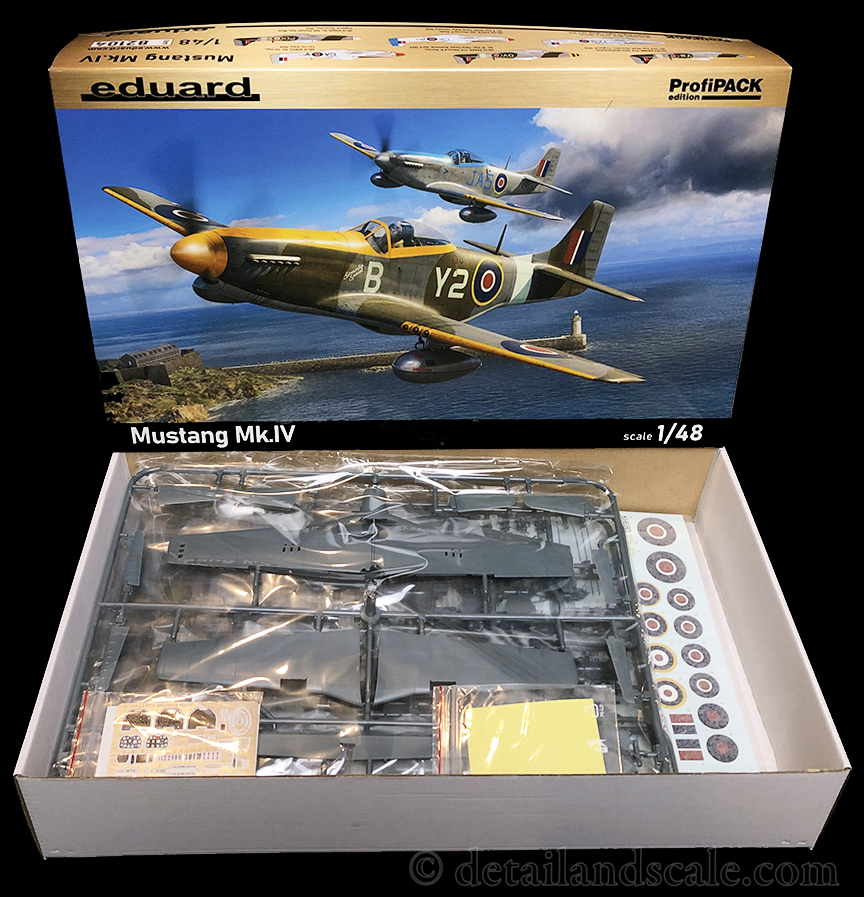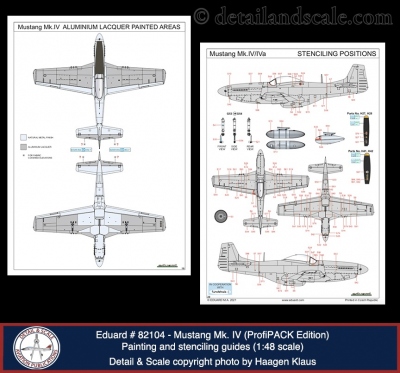Eduard # 82104 Mustang Mk.IV – ProfiPACK Edition —
1:48 Scale

In 2019, Eduard released the first of a growing family of P-51 Mustangs in 1:48 scale. By 2021, many different issues of their Mustang kit have hit the streets, all of which we have reviewed at Detail & Scale (and which you can find HERE). In this review, we take a look at their most recent Mustang: the RAF Mustang Mk. IV ProfiPACK edition.

The origins of the P-51 famously resided in an early 1940 request from Great Britain for a stopgap fighter to help hold the line against the German Luftwaffe. North American Aviation developed a completely new fighter that would be not just be easier and faster to produce but that also featured a number of revolutionary design features including its famous laminar flow wings. Early versions went into combat with the RAF in early 1943. RAF Mustang Marks I and II were soon followed by the improved P-51As, Bs, and Cs operated by the USAAF and the RAF. The definitive P-51D was fitted with a Plexiglas bubble canopy providing excellent 360-degree visibility. The aircraft could reach approximately 440 MPH while its service ceiling was just below 42,000 feet. Armament consisted of six wing-mounted .50-caliber machine guns, and underwing pylons permitted the use of range-extending drop tanks, rockets, and bombs. P-51s saw action in the European, North African, Mediterranean, Pacific and CBI theaters. Mustangs claimed 4,950 air-to-air kills. In USAAF service, P-51s, with their very long range, escorted bomber formations over Europe beginning in 1943, and they operated as ground attack and close air support aircraft following D-Day.
P-51Ds and P-51Ks were purchased by Great Britain to supplement U.K.-built RAF variants. P-51Ds operated by the RAF were designated as the Mustang Mk. IV, and P-51Ks as the Mustang Mk. IVa (828 aircraft in total; 282 Mk IVs and 600 Mk IVa airframes). The first combat-ready Mustangs were delivered in the U.K. from September 1944 to January 1945. The Dallas Factory exclusively manufactured these particular airplanes. In service, Mustang Mk. IVs escorted USAAF and RAF bomber formations, conducted fighter sweeps over occupied Europe, and attempted to intercept V-1 flying bombs inbound to England.

Eduard’s ProfiPACK edition of their 1:48 scale Mustang Mk. IV consists of 248 parts (about 100 parts are not used in this version of the kit). Seventeen clear parts come on one clear sprue. It also contains 78 photoetched metal detail parts on one fret (most of them are pre-painted). There is also a pre-cut, self-adhesive masking set for the windscreen, canopy, and wheel hubs. Markings for six aircraft include:
- Mustang Mk. IVa KH680 “Edmonton Special” (P-51K-1-NT; 44-11383), P.O. John Mallandaine, No. 442 Sqn, RCAF, Hunsdon, England, April 1945
- Mustang Mk. IVa KM232 (P-51K-10-NT; 44-12355), W/Cdr James E. Storrar, Hunsdon Wing CO, Digby, England, April 1945
- Mustang Mk. IV KH655 (P-51D-5-NT; 44-11182) F.O. Edward R. Davies, No.19 Sqn, Peterhead, Scotland, April 1945
- Mustang Mk. IVa KH716 (P-51K-1-NT; 44-11483), S.Ldr Murray P. Nash, No.3 Sqn RAAF, Fano, Italy, January 1945
- Mustang Mk. IVa KH852 (P-51K-5-NT; 44-11840), No.112 Sqn, Cervia, Italy, April 1945
- Mustang Mk. IV LH663 (P-51D-5-NT; 44-11255), No.303 (Polish) Sqn, Wick, England, December 1945
Strengths: We have reviewed various issues of the Eduard 1:48 scale Mustang. This kit of the Mustang Mk. IV shares in all of the virtues and strengths of the common Eduard tooling – which represents, in your reviewer’s opinion, the best 1:48 scale P-51D that is currently available from any manufacturer.
Overall, Eduard’s family of Mustang kits boasts very accurate surface details. Eduard has nailed the mostly featureless wing surfaces. Rivet/fastener details on the fuselage and tail surfaces are as exquisite as they are sublime. Fits between the fuselage halves and wings are just about airtight, and the engineering is fundamentally good. Eduard’s Mustang also has a number of construction options, including an open or closed canopy, separate landing flaps, ailerons, rudders, elevators, radiator exhaust, three canopy styles, and shrouded or unshrouded exhaust stacks.
The cockpit features separate frames for the sidewalls, a multi-part seat, and excellent representations of the radio, battery, and fuel tank, down to the separate parts for the wiring and fuel line. The really impressive elements here are the photoetched parts which add a considerable amount of detail and visually interesting features to the cockpit. These include the pre-painted instrument dial faces, the gorgeous pre-painted harnesses (complete with simulated stitching details), various placards, and the photoetched throttles, trim wheel, and other parts. Overall, the cockpit looks excellent with these detail parts. Still, if PE parts are not your preference, alternate cockpit decals are provided, too.
The main gear well is the best of its kind in 1:48 scale, and it builds up from about 16 parts. It is very rich with detail, from the textures of the parts and ribs to the fuel lines and pump details. All that is missing are the smaller hydraulic and electrical lines, and the builder can add those relatively easily if they wish. There’s also a fully enclosed tail wheel well that looks excellent. Another nice feature is a single-piece gun port section on each wing. Unlike the Tamiya kit, for example, the gun barrels do not assemble out of upper and lower halves resulting in some tricky/ugly seam work. Eduard’s engineering approach here is good, but the fit can be a little hard to get just right, so test fit and use slow setting super glue. Also note that there is a blanking plate on the inside of each wing so that shell ejection ports do not open up into the deep, hollow inside of the wing for all to see.
The masking set will save a lot of time when masking the windscreen, canopy, and wheel hubs. The exhaust stacks are great, and even though they are injection-molded, the ends are nicely hollowed-out. Here, there’s no real need for a cast resin replacement set. The clear parts possess excellent optical quality, and the windscreen has an extended fairing around it, so gluing, masking, and painting is a very low-risk affair.
The markings options are a true highlight of this boxing. There are at least three options that would draw me to buy a few copies of this kit simply to just to have the opportunity built these schemes. RAF schemes were distinct from the USAAF Mustangs and are very colorful and interesting. This is especially true with the RCAF “Edmonton Special” in standard RAF camouflage with bright yellow spinner, upper cowling, windscreen, canopy, and wing leading edges. The natural metal/light blue schemes, especially the RAAF aircraft and the RAF bird with the impressive shark mouth nose art, are exceptionally appealing. The decals were printed in-house by Eduard, and they all look great. I can see no technical errors in printing. There’s also a valuable painting guide highlighting where natural metal versus aluminum lacquer-painted surfaces are found on silver P-51s. Note that the decals are of the “wet transfer” style of decals that Eduard has introduced over the last year. They are applied like any regular water slide decal, but after about 24 hours, the carrier film is gently peeled away, leaving behind only the decal itself.
Weaknesses: There are few substantive critiques that can be considered for this kit. One minor issue for some folks is that if PE parts are not your cup of tea, the detail on the pilot’s instrument panel is really minimal. The idea is to either use the PE parts or the kit supplied instrument panel decals. If you want to position the ailerons, rudder, and elevators in anything but the neutral position, you’ll need to remove their mounting tabs. Also, be really careful with the thin plastic strip that separates the left and right wheel wells on the lower wing half (Part B-15). It is pretty fragile, and in some kits, it is warped/bent inward because it is so fine. My sample is perfectly molded, but if that’s a problem in the kit you have, you will not really see it when the main gear wells doors are displayed open. If the gear are built-up in the retracted position, a small plastic shim under the area will fix it. The completed landing gear are a tad weak owing to very shallow mounting pins, so watch out when handling.

Eduard has delivered another great 1:48 scale Mustang kit here, and the RAF’s Mk. IV/Mk.IVa features an excellent combination of detail, allure, and gorgeous markings options. Of course, you can always add more detail, and Eduard has released a range of aftermarket super detail sets for their Mustangs, including a Brassin cockpit set, and engine set, a wing gun set, and more. Even more 1:48 scale Mustangs are on the horizon from Eduard, and we certainly look forward to these forthcoming releases.
Sincere thanks to everyone at Eduard for the review sample. You can visit them on the web at http://www.eduard.comand on Facebook at https://www.facebook.com/EduardCompany.
Haagen Klaus
Scale Modeling News & Reviews Editor
Detail & Scale



